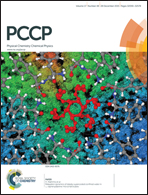Cerium oxide as a promoter for the electro-oxidation reaction of ethanol: in situ XAFS characterization of the Pt nanoparticles supported on CeO2 nanoparticles and nanorods†
Abstract
In this study we probe the electrocatalytic activity of Pt nanoparticles supported on ceria nanoparticles (NPs) and nanorods (NRs) in the ethanol oxidation reaction (EOR) in alkaline media. The goal of this study was to relate morphology, support structure and composition to the EOR catalytic activity by using in situ X-ray absorption fine structure (XAFS) studies. Cyclic voltammetry experiments showed that both ceria supported catalysts (NP vs. NR) had similar peak current densities at fast scan rates, however at slow scan rates, the ceria NR catalyst showed superior catalytic activity. In situ XAFS studies in KOH showed that both ceria supported catalysts had more electron density in their d-band (with the ceria NR having more electron density overall) than ceria – free Pt/Vulcan standard. However, in an ethanol solution the ceria NR catalyst had the least electron density. We propose that this change is due to the increased charge transfer efficiency between the ceria nanorod support and platinum. In the KOH solution, the increased electron density makes the platinum less electrophilic and hinders Pt–OH bond formation. In the EtOH solution, platinum's increased nucleophilicity facilitates the bond formation between Pt and the electron deficient carbon in ethanol which in turn withdraws the electron density from platinum and increases the white line intensity as observed in the XAS measurements.


 Please wait while we load your content...
Please wait while we load your content...